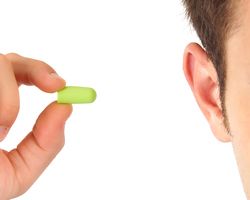What hearing protectors are right for you?

Oct. 13, 2022—It's a noisy world out there—and at home too. Leaf blowers. Concerts. Power tools. Sporting events. Fireworks. Loud motorcycles and trucks. Movie theaters. TVs, radio or stereos.
All that noise can damage your inner ear. Over time, it can take a toll on your hearing. Luckily, you can preserve this important sense with ear protection and some common sense.
Hearing protection options
Need to shout to be heard by someone next to you? That noise level is loud enough to cause hearing loss. If you can't avoid the noise, you'll need hearing protection. There are a lot of options out there—so you can make the choice that's best for your needs. Here's a look at some common forms of ear protection, with information from the Centers for Disease Control and Prevention and the National Institute on Deafness and Other Communication Disorders:
- Formable earplugs. These expanding foam earplugs are comfortable and inexpensive and come in different protection levels. Some are disposable, and others can be reused. Check the package to verify the level of noise they can protect you from. Many can protect your hearing while you use power tools, a gas-powered mower or leaf blower, for example, or while you ride a motorcycle or ATV.
- Pre-molded earplugs. These plastic, rubber or silicone earplugs have a flexible series of cups that conform to your ear canal. They come in sizes for everyone from children to adults. One type, called high-fidelity earplugs, lower volume while preserving sound quality. These are perfect for concerts or when playing in a band.
- Canal caps. These earplugs are on the end of a flexible metal or plastic band. They use gentle force to keep the earplugs in your ear canal. During quiet times, they can hang around your neck until you need them.
- Earmuffs. These plastic ear cushions come on a flexible headband. Offered in a variety of sizes, they reduce noise by completely covering both ears. This easy option may be more comfortable for young kids. And they can be worn with earplugs for added protection.
A wide variety of ear protection devices are readily available in stores or online. Make a fashion statement with bright colors or hide them discretely under your hair or a hat. Or ask a hearing professional about getting custom earplugs that fit the size and shape of your individual ears.
Be prepared
Keep a supply of earplugs in your pocket, bag, car, garage or work area. If you don't have earplugs on hand, there are still things you can do:
- Turn down the volume, if possible.
- Move away from the source of noise.
- Cover your ears tightly with your hands or hold your ear canal shut with your fingers.
- Take breaks from the noise.
Concerned about your hearing? Learn more about preventing and recognizing hearing loss in our Ears topic center.
